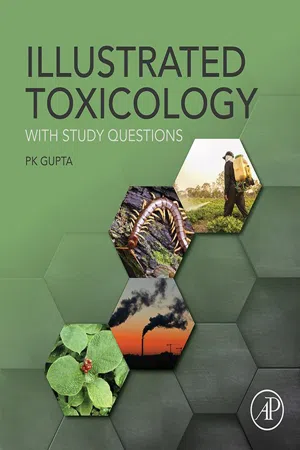
- 630 pages
- English
- ePUB (mobile friendly)
- Available on iOS & Android
About this book
Illustrated Toxicology: With Study Questions is an essential, practical resource for self-study and guidance catering to a broad spectrum of students. This book covers a range of core toxicological areas, including pesticides, radioactive materials and poisonous plants, also presenting a section on veterinary toxicology. Across 16 chapters, the book presents key concepts with the aid of over 250 detailed, full-color illustrations. Each section is supplemented with practical exercises to support active learning. This combination of clear illustrations and sample testing will help readers gain a deeper understanding of toxicology.This book is useful for toxicology, pharmacy, medical and veterinary students, and also serves as a refresher for academics and professionals in the field, including clinical pharmacists, forensic toxicologists, environmentalists and veterinarians.- Includes comprehensive coverage of key toxicological concepts for study and revision- Provides a visual learning aid with over 250 full-color illustrations- Enhances understanding and memory retention of core concepts with the use of practical exercises
Frequently asked questions
- Essential is ideal for learners and professionals who enjoy exploring a wide range of subjects. Access the Essential Library with 800,000+ trusted titles and best-sellers across business, personal growth, and the humanities. Includes unlimited reading time and Standard Read Aloud voice.
- Complete: Perfect for advanced learners and researchers needing full, unrestricted access. Unlock 1.4M+ books across hundreds of subjects, including academic and specialized titles. The Complete Plan also includes advanced features like Premium Read Aloud and Research Assistant.
Please note we cannot support devices running on iOS 13 and Android 7 or earlier. Learn more about using the app.
Information
General toxicology
Abstract
Keywords
1.1 Definitions and Subdisciplines of Toxicology
- Q. Definition
The traditional definition of toxicology is “the science of poisons.” As our understanding of how various agents can cause harm to humans and other organisms, a more descriptive definition of toxicology is “the study of the adverse effects of chemicals or physical agents on living organisms.”
Explanation: The word “toxicology” is derived from the Greek word “toxicon” which means “poison” and logos means to study. It also includes study of special effects of toxicants developmental toxicity, teratogenicity, carcinogenicity, mutagenesis, immune-toxicity, neurotoxicity, endocrine disruption, etc. Adverse effects may occur in many forms, ranging from immediate death to subtle changes not realized until months or years later. They may occur at various levels within the body, such as an organ, a type of cell, or a specific biochemical. Knowledge of how toxic agents damage the body has progressed along with medical knowledge. It is now known that various observable changes in anatomy or body functions actually result from previously unrecognized changes in specific biochemicals in the body. - Q. Define xenobiotics.
Xenobiotic: Xenobiotics (xeno is a Greek word which means “strange or alien”) are the substances which are foreign to the body and are biologically active. These cannot be broken down to generate energy or be assimilated into a biosynthetic pathway. It is a very wide class and structurally adverse agents, both natural and synthetic chemicals such as drugs, industrial chemicals, pesticides, alkaloids, secondary plant metabolites and toxins of molds, plants and animals, and environmental pollutants. - Q. What are the subdisciplines of toxicology?
- Biochemical toxicology
- Reproductive toxicology
- Development toxicology
- Teratology
- Genetic toxicology
- Clinical toxicology
- Forensic toxicology
- Analytical toxicology
- Nutritional toxicology
- Veterinary toxicology
- Environmental toxicology
- Occupationa...
Table of contents
- Cover image
- Title page
- Table of Contents
- Copyright
- Disclaimer
- Preface
- Chapter 1. General toxicology
- Chapter 2. Disposition
- Chapter 3. Mechanism of toxicity
- Chapter 4. Target organ toxicity
- Chapter 5. Pesticides (agrochemicals)
- Chapter 6. Metals and micronutrients
- Chapter 7. Nonmetals and micronutrients
- Chapter 8. Solvents, vapors, and gases
- Chapter 9. Poisonous and venomous organisms
- Chapter 10. Poisonous foods and food poisonings
- Chapter 11. Poisonous plants
- Chapter 12. Drugs of use, dependence, and abuse
- Chapter 13. Radioactive materials
- Chapter 14. Environmental and ecotoxicology
- Chapter 15. Veterinary toxicology
- Chapter 16. Clinical toxicology
- Chapter 17. Brainstorming: Toxicology question bank
- Index